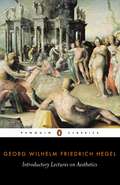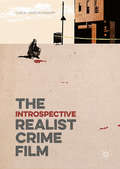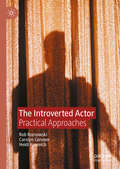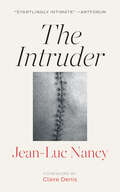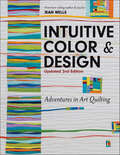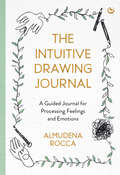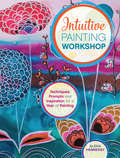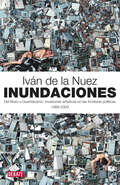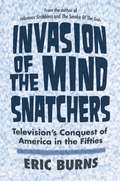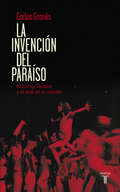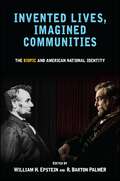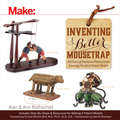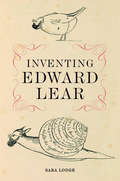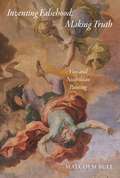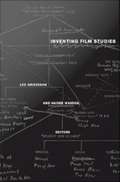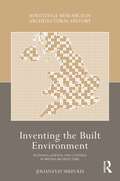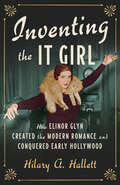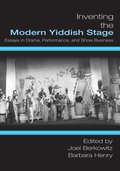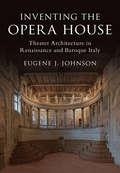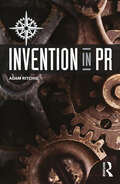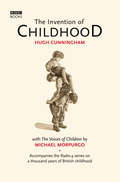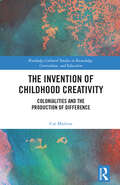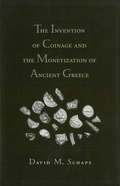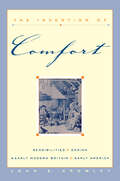- Table View
- List View
Introductory Lectures on Aesthetics
by Georg HegelNo philosopher has held a higher opinion of art than Hegel, yet nor was any so profoundly pessimistic about its prospects - despite living in the German golden age of Goethe, Mozart and Schiller. For if the artists of classical Greece could find the perfect fusion of content and form, modernity faced complicating - and ultimately disabling - questions. Christianity, with its code of unworldliness, had compromised the immediacy of man's relationship with reality, and ironic detachment had alienated him from his deepest feelings. Hegel's Introductory Lectures on Aesthetics were delivered in Berlin in the 1820s and stand today as a passionately argued work that challenged the ability of art to respond to the modern world.
The Introspective Realist Crime Film
by Luis M. García-MainarThis book explores the formal and thematic conventions of crime film, the contexts in which these have flourished and their links with the social issues of a globalized world. The crime film has traditionally been identified with suspense, a heterogeneous aesthetic and a tacit social mind. However, a good number of the crime films produced since the early 2000s have shifted their focus from action or suspense and towards melodrama in narratives that highlight the social dimension of crime, intensify their realist aesthetics and dwell on subjectivity. With the 1940s wave of Hollywood semi-documentary crime films and 1970s generic revisionism as antecedents, these crime films find inspiration in Hollywood cinema and constitute a transnational trend. With a close look at Steven Soderbergh's Traffic (2000), David Fincher's Zodiac (2007), Jacques Audiard's Un prophète (2009) and Tomas Alfredson's Tinker Tailor Soldier Spy (2011), this book sets out the stylistic and thematic conventions, contexts and cultural significance of a new transnational trend in crime film.
The Introverted Actor: Practical Approaches
by Rob Roznowski Carolyn Conover Heidi KasevichDo you have to be an extrovert to succeed as an actor? This book offers ideas to create inclusive acting environments where the strengths of the introverted actor are as valued as those of their extroverted counterparts. As this book shows, many introverts are innately drawn to the field of acting, but can often feel inferior to their extroverted peers. From the classroom to professional auditions, from rehearsals to networking events, introverted actors tell their stories to help other actors better understand how to leverage their natural gifts, both onstage and off. In addition, The Introverted Actor helps to reimagine professional and pedagogical approaches for both actor educators and directors by offering actionable advice from seasoned psychology experts, professional actors, and award-winning educators.
The Intruder
by Jean-Luc NancyIn 1991, Jean-Luc Nancy's heart gave out. In one of the first such procedures in France, a stranger's heart was grafted into his body. Numerous complications followed, including more surgeries and lymphatic cancer. The procedure and illnesses he endured revealed to him, in a more visceral way than most of us ever experience, the strangeness of bodily existence itself and surviving the stranger within him. During this same period, Europe began closing its borders to those seeking refuge from war and poverty. Alarmed at this trend and drawn to a highly intimate form of strangeness with which he had been living for years, Nancy set out in The Intruder to articulate how intrusion—whether of a body or a border—is not antithetical to one’s identity but constitutive of it. In 2004, Claire Denis adapted The Intruder into a film already hailed among the most important of our century. This edition includes Nancy’s and Denis’s accounts of turning philosophy into film and the text of a shorter collaboration between the two of them. Throughout, Nancy and Denis push us to recognize that to truly welcome strangers means a constant struggle against exoticism, enforced assimilation, and confidence in our own self-identity.
Intuitive Color & Design: Adventures in Art Quilting
by Jean WellsThink outside the block and look what happens! Jean Wells gives you the assignment of your life: put away your ruler and use your inner vision to design and piece spectacular, free-form quilts you'd never have guessed you could create. In this updated edition of best-selling Intuitive Color & Design, Jean’s workshop assignments get your creative juices flowing, giving you challenges to expand your quilting horizons. Start by learning to see line and color; study the nuts and bolts of design; develop your color work and composition; and when you get stuck, there’s expert advice on problem solving. You will never see quiltmaking in the same way again. • Creative exercises take your use of color, line, design, and piecing in dramatic new directions • Use photographs and journals to find inspiration and develop your ideas with Jean’s updated, expert guidance • Learn innovative finishing techniques to show your quilts at their best • Classroom-proven techniques make the adventure easy for any quilter
The Intuitive Drawing Journal: A Guided Journal for Processing Feelings and Emotions
by Almudena RoccaProcess your emotions and improve your wellbeing with this inspiring guided journal which introduces intuitive drawing as an evolution of mindful drawing.What if drawing could help you express and process your emotions?Emotions add depth to our experiences, but sometimes they can be overwhelming or challenging. In this beautifully illustrated guided journal, Almudena Rocca presents an amazing technique – intuitive drawing – which will help you to understand and work through your feelings by accessing your unconscious.You will learn essential intuitive drawing skills, from working with patterns to drawing objects, before diving into 11 core emotions, including anger, fear and trust. This journal is filled with thought-provoking drawing prompts and quotes, allowing you to explore memories, relationships and events that may still impact you today.You don&’t need to be an artist to enjoy this book – it is the perfect resource for anyone who enjoys creative self-care.
Intuitive Painting Workshop: Techniques, Prompts and Inspiration for a Year of Painting
by Alena HennessyA Year of Painting Intuitively!Stay inspired to create art throughout every season! In Intuitive Painting Workshop, you'll find a timely expressive exercise for each month, along with seasonal check-ins. In discovering how to paint intuitively, you will learn to surrender to your true visual voice as your personal process of making marks emerges. Using acrylic paint, ink, collage papers, stencils, watercolor, gel pens, paint markers and more, you'll be gently guided by twelve exercises, taking cues from the process, but carrying each in your own direction.Explore monthly exercises, each offering you a new area of growth from setting intentions, to painting wildly, to getting know your animal totems and much more.Receive suggestions for painting with a "beginner's mind" and a glossary of art terms will make following the step-by-step demonstrations clear and easy to understand.Get further ideas from a monthly gallery of contributing artists who were students of this process, just like you!Have a chance to assimilate your creative focus every few months with seasonal Check-In journaling prompts and ideas for reflection.Stay inspired month-by-month and season-to-season with Intuitive Painting Workshop!
Inundaciones: Del Muro a Guantánamo: invasiones artísticas en las fronteras políticas
by Iván de NuezUn repaso a los grandes temas del arte contemporáneo desde 1989. Veinte años de transformaciones políticas. Veinte años de arte contemporáneo. Solo veinte años van de la caída del muro al desmantelamiento de la prisión de Guantánamo. Del fin de la Guerra Fría a la confirmación de la impotencia estadounidense para controlar el mundo que surgió del colapso comunista. A modo de dietario, con un capítulo por cada uno de los 21 años transcurridos, Iván de la Nuez recorre, con su brillantez habitual, todos los recovecos de nuestra experiencia para iluminar el impacto del arte en la historia contemporánea, y de la historia contemporánea en el arte. Un ensayo que demuestra la irremediable unión que existe entre arte, política y sociedad
Invasion of the Mind Snatchers: Television's Conquest of America in the Fifties
by Eric BurnsWhen the first television was demonstrated in 1927, a headline in The New York Timesread, “Like a Photo Come to Life. ” It was a momentous occasion. But the power of television wasn’t fully harnessed until the 1950s, when the medium was, as Eric Burns says, “At its most preoccupying, its most life-altering. ” And Burns, a former NBC News correspondent who is an Emmy-winner for his broadcast writing,knows about the impact of television. Invasion of the Mind Snatcherschronicles the influence of television that was watched daily by the baby boomer generation. As kids became spellbound by Howdy Doodyand The Ed Sullivan Show,Burns reveals, they often acted out their favorite programs. Likewise, they purchased the merchandise being promoted by performers, and became fascinated by the personalities they saw on screen, often emulating their behavior. It was the first generation raised by TV and Burns looks at both the promise of broadcasting as espoused by the inventors, and how that promise was both redefined and lost by the corporations who helped to spread the technology. Yet Burns also contextualizes the social, cultural, and political events that helped shape the Fifties-from Sputnik and the Rosenberg trial to Senator Joseph McCarthy’s Red Scare. In doing so, he charts the effect of television on politics, religion, race, and sex, and how the medium provided a persuasive message to the young, impressionable viewers.
La invención del paraíso
by Carlos Granés¿Puede el arte transformar la sociedad? El Living Theatre es el último intento de revolución desde la cultura. Es la historia de una utopía, de sus contradicciones y de su imposibilidad. ¿Influye de alguna manera el arte sobre el ser humano? ¿Transforma su conciencia? ¿Cambia su vida? En la apasionante historia cultural del siglo XX nadie intentó responder estas preguntas con tanto empeño como el Living Theatre. Eslabón entre la vanguardia europea, la generación beat, el hippismo y el tercermundismo, el legendario grupo de teatro experimental liderado por Judith Malina y Julian Beck se planteó un ambicioso objetivo: primero quisieron revolucionar la sociedad estadounidense con sus obras, en especial con Paradise Now, y luego liberar a los brasileños sometidos por la dictadura militar del general Médici con otrade sus creaciones, El legado de Caín, inspirada en las turbulentas novelas de Sacher-Masoch. Lanzaron una revolución cultural en una democracia y meses después en una dictadura. ¿Cuáles fueron los resultados de esas dos batallas? ¿Logró el Living Theatre cambiar la realidad? Tanto en su peregrinaje a lo largo y ancho de Estados Unidos llevando el mensaje de Paradise Now, como en su búsqueda de los más pobres entre los pobres en las favelas y barriadas de São Paulo, Río de Janeiro y Ouro Preto, el grupo se reunió y conspiró con las grandes personalidades de la cultura de todo el continente. Quiso inventar un Paraíso y finalmente lo consiguió. Pero, ¿era el que buscaba? Hasta el día de hoy, el Living Theatre ha luchado por ampliar la esfera de libertades, actuando no solo con osadía, sino con valentía, para desafiar el autoritarismo y las convenciones que acotan la libertad individual. La crítica ha dicho... «Este ensayo es ideal para entender el papel del teatro experimental en el avance de la sociedad a través de sus propuestas políticas y de una suerte de utopía comunitaria.» La Razón
Invented Lives, Imagined Communities: The Biopic and American National Identity (SUNY series, Horizons of Cinema)
by William H. Epstein; R. Barton PalmerBiopics—films that chronicle the lives of famous and notorious figures from our national history—have long been one of Hollywood's most popular and important genres, offering viewers various understandings of American national identity. Invented Lives, Imagined Communities provides the first full-length examination of US biopics, focusing on key releases in American cinema while treating recent developments in three fields: cinema studies, particularly the history of Hollywood; national identity studies dealing with the American experience; and scholarship devoted to modernity and postmodernity. Films discussed include Houdini, Patton, The Great White Hope, Bound for Glory, Ed Wood, Basquiat, Pollock, Sylvia, Kinsey, Fur, Milk, J. Edgar, and Lincoln, and the book pays special attention to the crucial generic plot along which biopics traverse and showcase American lives, even as they modify the various notions of the national character.
Inventing a Better Mousetrap: 200 Years of American History in the Amazing World of Patent Models
by Alan Rothschild Ann RothschildLearn about the role that patent models played in American history--and even learn to build your own replica!Patent models, working models required for US patent filings from 1790 to 1880, offer insight into--and inspiration from--a period of intense technological advancement, the Industrial Revolution. The Rothschild Patent Model Collection consists of thousands of patent models, many from the 19th century. This book features the most outstanding of these patent models, and offers deep insight into the cultural, economic, and political history of the United States.This book not only catalogs hundreds of the most compelling models from the collection, but shows you how to build your own replicas of several selected models using Lego, 3D printing, and other materials and techniques.
Inventing Edward Lear
by Sara LodgeEdward Lear—the father of nonsense—wrote some of the best-loved poems in English. He was also admired as a naturalist, landscape painter, travel writer, and composer. Awkward but funny, absurdly sympathetic, Lear invented himself as a Victorian character. Sara Lodge offers a moving account of one of the era’s most influential creative figures.
Inventing Falsehood, Making Truth: Vico and Neapolitan Painting (Essays in the Arts)
by Malcolm BullHow the philosophy of Giambattista Vico was influenced by eighteenth-century Neopolitan paintingCan painting transform philosophy? In Inventing Falsehood, Making Truth, Malcolm Bull looks at Neapolitan art around 1700 through the eyes of the philosopher Giambattista Vico. Surrounded by extravagant examples of late Baroque painting by artists like Luca Giordano and Francesco Solimena, Vico concluded that human truth was a product of the imagination. Truth was not something that could be observed: instead, it was something made in the way that paintings were made--through the exercise of fantasy.Juxtaposing paintings and texts, Bull presents the masterpieces of late Baroque painting in early eighteenth-century Naples from an entirely new perspective. Revealing the close connections between the arguments of the philosophers and the arguments of the painters, he shows how Vico drew on both in his influential philosophy of history, The New Science. Bull suggests that painting can serve not just as an illustration for philosophical arguments, but also as the model for them--that painting itself has sometimes been a form of epistemological experiment, and that, perhaps surprisingly, the Neapolitan Baroque may have been one of the routes through which modern consciousness was formed.
Inventing Film Studies
by Lee Grieveson Haidee WassonInventing Film Studies offers original and provocative insights into the institutional and intellectual foundations of cinema studies. Many scholars have linked the origins of the discipline to late-1960s developments in the academy such as structuralist theory and student protest. Yet this collection reveals the broader material and institutional forces--both inside and outside of the university--that have long shaped the field. Beginning with the first investigations of cinema in the early twentieth century, this volume provides detailed examinations of the varied social, political, and intellectual milieus in which knowledge of cinema has been generated. The contributors explain how multiple instantiations of film study have had a tremendous influence on the methodologies, curricula, modes of publication, and professional organizations that now constitute the university-based discipline. Extending the historical insights into the present, contributors also consider the directions film study might take in changing technological and cultural environments. Inventing Film Studies shows how the study of cinema has developed in relation to a constellation of institutions, technologies, practices, individuals, films, books, government agencies, pedagogies, and theories. Contributors illuminate the connections between early cinema and the social sciences, between film programs and nation-building efforts, and between universities and U. S. avant-garde filmmakers. They analyze the evolution of film studies in relation to the Museum of Modern Art, the American Film Council movement of the 1940s and 1950s, the British Film Institute, influential journals, cinephilia, and technological innovations past and present. Taken together, the essays in this collection reveal the rich history and contemporary vitality of film studies. Contributors: Charles R. Acland, Mark Lynn Anderson, Mark Betz, Zo Druick, Lee Grieveson, Stephen Groening, Haden Guest, Amelie Hastie, Lynne Joyrich, Laura Mulvey, Dana Polan, D. N. Rodowick, Philip Rosen, Alison Trope, Haidee Wasson, Patricia White, Sharon Willis, Peter Wollen, Michael Zryd
Inventing the Built Environment: Planning, Science, and Control in British Architecture (Routledge Research in Architectural History)
by Juliana Yat KeiWhy and how was the term ‘built environment’ first introduced? Inventing the Built Environment retrieves the origin of this ubiquitous term. The articulation of the ‘built environment,’ Kei demonstrates, coincided with the redefinition of education, research, and professional practices in architecture and town planning in 1960s Britain.Concentrating on the half-decade during which the term permeated the architectural and planning professions, this book recalls a time when the ‘built environment’ was conceived as a part of the British government’s effort in national economic planning. Inventing the Built Environment unpacks the proposal for a Research Council for the Built Environment to mobilise architecture and town planning for political economy. How a relatively small group of architects, planners, politicians, and researchers transposed scientific thoughts from biology, economics, and computation into the ‘built environment’ will be considered, too. Kei highlights the assumptions about and classification of the population that were made when inventing the ‘built environment.’ The architectural and biosocial implications of the making and remaking of this architectural-environmental notion, in Britain and beyond, will be revealed through the works of pre-eminent architect-planners including Richard Llewelyn-Davies and William Holford.At a time when environmental concerns again take the front seat of architectural and planning debates, this book offers, for scholars and students, an alternative lens to reflect on the assumptions and bias that can be embedded in our architectural lexicons.
Inventing the It Girl: How Elinor Glyn Created The Modern Romance And Conquered Early Hollywood
by Hilary A. HallettA Publishers Weekly Summer Reads Selection The modern romance novel is elevated to a subject of serious study in this addictively readable biography of pioneering celebrity author Elinor Glyn. Unlike typical romances, which end with wedding bells, Elinor Glyn’s (1864–1943) story really began after her marriage up the social ladder and into the English gentry class in 1892. Born in the Channel Islands, Elinor Sutherland, like most Victorian women, aspired only to a good match. But when her husband, Clayton Glyn, gambled their fortune away, she turned to her pen and boldly challenged the era’s sexually straightjacketed literary code with her notorious succes de scandale, Three Weeks (1907). An intensely erotic tale about an unhappily married woman’s sexual education of her young lover, the novel got Glyn banished from high society but went on to sell millions, revealing a deep yearning for a fuller account of sexual passion than permitted by the British aristocracy or the Anglo-American literary establishment. In elegant prose, Hilary A. Hallett traces Glyn’s meteoric rise from a depressed society darling to a world-renowned celebrity author who consorted with world leaders from St. Petersburg to Cairo to New York. After reporting from the trenches during World War I, the author was lured by American movie producers from Paris to Los Angeles for her remarkable third act. Weaving together years of deep archival research, Hallett movingly conveys how Glyn, more than any other individual during the Roaring Twenties, crafted early Hollywood’s glamorous romantic aesthetic. She taught the screen’s greatest leading men to make love in ways that set audiences aflame, and coined the term “It Girl,” which turned actress Clara Bow into the symbol of the first sexual revolution. With Inventing the It Girl, Hallett has done nothing less than elevate the origins of the modern romance genre to a subject of serious study. In doing so, she has also reclaimed the enormous influence of one of Anglo-America’s most significant cultural tastemakers while revealing Glyn’s life to have been as sensational as any of the characters she created on the page or screen. The result is a groundbreaking portrait of a courageous icon of independence who encouraged future generations to chase their desires wherever they might lead.
Inventing the Modern Yiddish Stage: Essays in Drama, Performance, and Show Business
by Barbara Henry Joel BerkowitzCollects leading scholars' insight on the plays, production, music, audiences, and political and aesthetic concerns of modern Yiddish theater.
Inventing the Opera House: Theater Architecture In Renaissance And Baroque Italy
by Eugene J. JohnsonIn this book, Eugene J. Johnson traces the invention of the opera house, a building type of world wide importance. <P><P>Italy laid the foundation theater buildings in the West, in architectural spaces invented for the commedia dell'arte in the sixteenth century, and theaters built to present the new art form of opera in the seventeenth. Rulers lavished enormous funds on these structures. Often they were among the most expensive artistic undertakings of a given prince. They were part of an upsurge of theatrical invention in the performing arts. At the same time, the productions that took place within the opera house could threaten the social order, to the point where rulers would raze them. Johnson reconstructs the history of the opera house by bringing together evidence from a variety of disciplines, including music, art, theatre, and politics. Writing in an engaging manner, he sets the history of the opera house within its broader early modern social context.<P> This is the only book, since the 1930s, to cover this subject, and the only English language one to ever be produced.<P> Sets the subject into a broad context of the arts, politics, and social history of the period.<P> The book aims to reach both specialists and the general reader, making it appealing to those who know the field well and those who do not care to plow through scholarly jargon.
Invention in PR
by Adam RitchieA handbook for pushing the limits of PR to inventing things, rather than only promoting them. When PR teams live or die on the success or failure of the products and services they support, Invention in PR shows how they can take a stronger hand in their creation. This book says the profession can do better than waiting for someone else to determine, develop and package what a company sells. It spurs PR pros to go beyond what they're handed and come up with new products and services that change a brand's life. Through tales of award-winning campaigns passionately told by their creator, readers learn how to apply invention at the beginning of the PR process and take away usable strategies and tactics. With PR under constant pressure to evolve, communications pioneer Adam Ritchie uncovers practitioners' aptitude for invention and empowers them to harness it. For PR professionals ready to rebel against taking a back seat to their counterparts in marketing and advertising, Invention in PR teaches them how to beat every other discipline to the punch by coming up with the product or service idea first. This guide will fire up professionals of all generations about what they can build. It will change the way experienced pros approach their jobs, and inspire students to break the rules in the best possible ways.
The Invention of Art: A Cultural History
by Larry ShinerWith The Invention of Art, Larry Shiner challenges our conventional understandings of art and asks us to reconsider its history entirely, arguing that the category of fine art is a modern invention—that the lines drawn between art and craft resulted from key social transformations in Europe during the long eighteenth century.
The Invention of Childhood
by Hugh CunninghamThe Invention of Childhood will paint a vivid picture of the lives of children in Britain from pagan Anglo-Saxon times to the present day. Drawing heavily on primary sources, such as diaries, autobiographies, paintings, photographs and letters, the book will present a complete chronological history of the experience of children in Britain during the past 1500 years. We will learn the key elements that have shaped their lives down the ages and how this has differed as a result of gender, geography and ethnicity. The book will also relate children's lives to larger events in national and international history. Written by Hugh Cunningham the Professor of History at the Universtity of Kent at Canterbury, and an expert on childhood history - the book will accompany the Radio 4 series presented by the highly respected children's author Michael Morpurgo. Michael is contributing a lengthy foreword to the book. 'The Invention of Childhood' will expand on a number of key themes from the radio series, including the idea of childhood as a distinct stage of life. Opinions on when childhood should start and end, and how it differs from adulthood have changed considerably down the centuries. And these inventions and reinventions of childhood (hence the title) have had a profound effect on children's lives. The prolonged childhood we enjoy in Britain today was a luxury few could afford in the past. This fascinating study will draw attention to the ways in which we may find childhood and children in the past quite similar to the present and to ways in which childrens lives from the past seem to differ sharply from the lives children lead today.
The Invention of Childhood Creativity: Colonialities and the Production of Difference (Routledge Cultural Studies in Knowledge, Curriculum, and Education)
by Cat MartinsThis text offers a comprehensive analysis of the concept of the modern creative and imaginative child in Western education. Drawing on archived sources and historical works, it reframes childhood creativity as a social, cultural, and scientific construction, asking how our thinking and acting toward the creative child have been produced historically. The text dissects the discursive construction of creativity as a natural and developmental attribute of the child. It argues that the idea of the White creative child, constructed through comparative reasoning, shaped by primitivism, and illustrated through botanical metaphors as close to nature and the senses, is a notion embedded with colonialities, forming part of a Western civilizing project and entrenched power-knowledge relations. A compelling and original account of childhood creativity, this text will appeal to researchers in arts education, early childhood education, curriculum studies, and the history of education.
The Invention of Coinage and the Monetization of Ancient Greece
by David M. SchapsCoinage appeared at a moment when it fulfilled an essential need in Greek society and brought with it rationalization and social leveling in some respects, while simultaneously producing new illusions, paradoxes, and new elites. In a book that will encourage scholarly discussion for some time, David M. Schaps addresses a range of important coinage topics, among them money, exchange, and economic organization in the Near East and in Greece before the introduction of coinage; the invention of coinage and the reasons for its adoption; and the developing use of money to make more money. David M. Schaps is Professor of Classics at Bar-Ilan University in Israel.
The Invention of Comfort: Sensibilities and Design in Early Modern Britain and Early America
by John E. CrowleyHow did our modern ideas of physical well-being originate? As John Crowley demonstrates in The Invention of Comfort, changes in sensible technology owed a great deal to fashion-conscious elites discovering discomfort in surroundings they earlier had felt to be satisfactory.Written in an engaging style that will appeal to historians and material culture specialists as well as to general readers, this pathbreaking work brings together such disparate topics of analysis as climate, fire, food, clothing, the senses, and anxiety—especially about the night.
